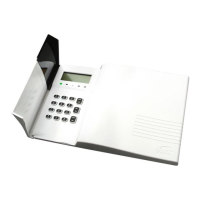80
Default Eng. Code - 4567 Default User Code - 1111 (Irl) 1234 (UK)
Comms Menu - Continued
934 REPORTS MENU
2 CHANNEL OPTIONS
1 PHONE REPORTS
There are three Channel Options for each channel; the delay
time (in seconds), whether it is a positive or negative going
trigger and whether you want a restore message or not. As an
example: Ch 2:Dly=00+NRES means that channel 2 has a
zero second delay on a positive going trigger and NO
RESTORE message will be sent.
Note 1: RES = RESTORE.
Channel Types and Channel Options are not required for SIA,
Extended SIA and Contact ID. However they can be used with those protocols
to control when an event is reported e.g. if you want to delay a Fire event
report by 30 seconds change Ch 1: Dly=00+RES to
Ch1: Dly=30+RE
Note 2: Positive and Negative triggers are a throwback to standalone digis. In
the context of an integrated digi you should, in general, leave the trigger
polarity as “+”
Note 3:
S (Channel 1 is typically for FIRE)
!
!
!
Each Fast Format channel type can be programmed to report
to any of the 4 central station phone numbers for instance, Fire
events can be reported to either phones 1 or 2 while Technical
events could be reported to phones 3 or 4. Remember when
you are doing this to disable Dual Report
For instance Fire :1234 means that a FIRE event is reported
to phone 1, 2, 3 and 4
Example: If you don’t want FIRE reported to phones 2 and 4, select
Fire :1234. See that the colon is flashing and then type digits 2 and 4. The
display should look like Fire :1-3-
1 CHANNEL TYPES
933 CHANNEL MENU
Channel Types is used to assign different events, like Fire,
Alarm etc., to each of the 16 Fast Format channels used in the
digi. So, for instance, Ch 2:Panic means that a Panic
activation will trigger channel 2 at your monitoring station - you
should contact them prior to installation to confirm your
channel configuration.
932 MAKE TEST CALL
Allows the installer to make a test call to one of their pre-
programmed telephone numbers without having to create an
event. You can make a test call to phones with the voice
protocol as well as the traditional monitoring station protocols.

